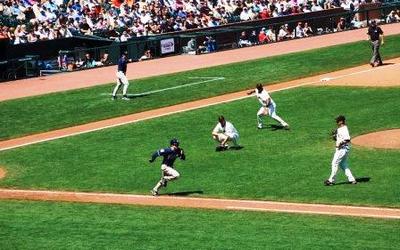Coverage of first base on a bunt
by Jim
(Yorktown, Virginia)

Bunt Coverage

Sacrifice Bunt, Runner On First

Second Baseman Covering First Base On A Bunt
Jim asked: If a bunt is hit about halfway to first base, what is the role of the pitcher, catcher, first baseman, and second baseman?
Specifically is this a situation where the pitcher would cover first base?
Also, how about coverage on that bunt when a runner is on first base?
My granddaughter's softball coach is telling them that in either of the above situations the second baseman covers first.
I say, the first baseman fields the bunt and the pitcher takes the throw at first with the second baseman backing up the throw to first.
Please clarify, thanks.
Rick answered: Jim, thank you for your question.
Looking at the first image above, the batter has bunted a ball, no runners on, looking for a base hit.
The 3b has the third base side, the pitcher has in front of the mound and the 1b has the first base line.
The ball has been fielded by the 3b and he is in the process of throwing to the 2b, who would be covering first base.
In your scenario, the ball has been bunted up the first base side, about halfway to first base, which is where the first base running lane starts.
As these bunts are most always a surprise, the defensive needs to be able to defend the 3 areas shown in the image.
For a ball up the first base side, the 1b should be calling that he has it, and the 2b should be covering first base.
Even if the pitcher were to react instantly to the bunt by going to first base, his back is to the play. The 2b is able to see everything in front of him, locate the base and set up for the throw.
The backup for this situation is the right fielder, who should be moving in that direction as soon as he sees the batter showing bunt.
The second image above is the default defense for a bunt when there is a runner on first.
As soon as the batter shows bunt, everyone on the defense should be on the move.
Depending on where the ball is bunted, the 1b and 3b are charging. If the ball is bunted up the third base line past the pitcher, then the 3b calls it and comes to field the bunt. The pitcher at that point goes to cover third base.
If the pitcher fields the bunt, then the 3b turns and gets back to cover third base.
The ss goes to cover second base, the 2b goes to cover first base.
The left fielder moves to backup third base in case there is a play there.
The center fielder heads towards second base to back up a throw there and the right fielder backs up the throw at first base.
If the catcher doesn't field the bunt, he is telling whoever fields the ball where to throw it, either second base or first base.
The catcher can also back up first base, on a throw to first from the ss, attempting to turn a double play on a hard bunt.
The thought process you are trying to teach is that there is always someplace a player should be moving to on defense.
There is additional information on the site at this link, baseball defensive situations. There is information on defensive concepts as well as situation specifics for the various situations that can be encountered.
Ty Cobb said he believed that it was 5 times harder for the defense to make a defensive play, than it was for an offensive team to make one.
Defense certainly does require much time and effort to be successful.
It all starts with the initial concept that "everyone has someplace they should be moving to, on every play." Once your defense is doing that, the rest is just physical execution.
Yours in baseball,
Rick
Click here to post comments
Join in and write your own page! It's easy to do. How? Simply click here to return to Ask The Baseball Coach.
|





